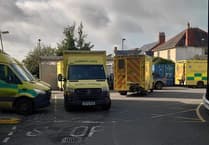The Welsh Government has been urged to act to ensure ambulance crews can respond to major incidents such as terror attacks following a stark warning recently issued by senior Welsh Ambulance Service officials that their ability to reach serious incidents could be hindered by hospital handover delays.
A report to members of the NHS trust’s board published last month highlighted the risk of “catastrophic harm” to members of the public if crews are tied up outside emergency departments.
The issue of handover delays and their impact was raised with ministers in the Senedd on 5 June.
Speaking in the chamber, Altaf Hussain MS said: “Last week, the Welsh Ambulance Services University NHS Trust warned that handover delays, which are in part due to a lack of social care staff, will impact the service’s ability to respond to major incidents, including terrorist attacks.
“Whatever the problem with our NHS, we could always rely upon it in a national emergency, but now, even that is not certain.”
In its report, the ambulance service questioned the effectiveness of procedures in place to release crews from outside hospitals during major incidents.
The service’s chief executive Jason Killens said up to 30,000 hours of emergency response time are lost every month in Wales due to long waits in transferring people to hospital.
He said it was harming patient safety, with average handover times standing at more than two hours, compared to the target of 15 minutes.
The Welsh Government said it expected health boards to reduce handover delays “as a priority” in response to the concerns.
Health Minister Eluned Morgan said ambulance staff numbers had increased, but system blockages still remained.
The minister said: “When it comes to the ambulance service, we have 13 per cent more people than we had three years ago, so significant additional numbers.
“You’re quite right that, when it comes to handover delays, there’s a real issue, and it is an issue that we are constantly going at.
“It is about where the responsibilities are within those health boards, who need to move people on, but also local government.”


Comments
This article has no comments yet. Be the first to leave a comment.